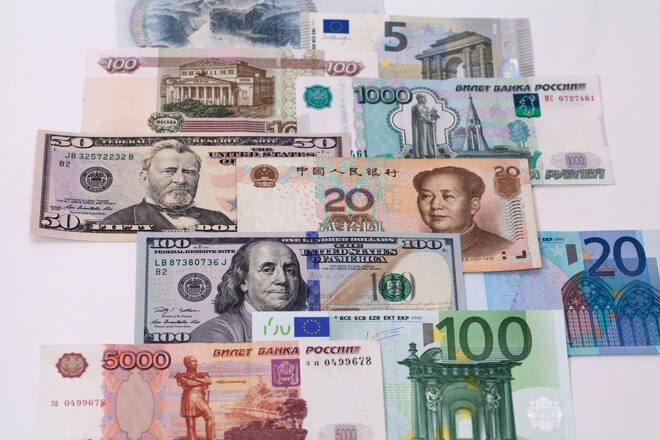Advertisement
Advertisement
A Busy Economic Calendar Puts the EUR, the Loonie, and the Dollar in Focus
By:
It's a particularly busy day ahead on the economic calendar. While stats from the Eurozone and Canada will influence, U.S consumer confidence will likely be the key stat of the day.
In this article:
Earlier in the Day:
It was a busy start to the day on the economic calendar this morning. The Kiwi Dollar, the Japanese Yen, and the Aussie Dollar were in action this morning. Economic data from China was also in focus.
For the Kiwi Dollar
Building consents and business confidence figures drew attention this morning as New Zealand looks to curb the latest COVID-19 outbreak.
Building consents had a relatively muted impact on the Kiwi Dollar this morning.
In July, consents rose by 2.10% month-on-month, following a 4.0% increase from June.
The ANZ Business Confidence Index fell from -3.8 to -14.2 in August. In spite of the decline, the Kiwi held on to early gains.
The Kiwi Dollar moved from $0.70225 to $0.70207 upon release of the figures. At the time of writing, the Kiwi Dollar was up by 0.53% to $0.70326.
For the Japanese Yen
Industrial production was the key stat of the morning for the Yen. Production fell by 1.50% in July, versus a forecasted 2.5% slide. In June, production had jumped by 6.5%.
According to the Ministry of Economy, Trade and Industry,
Industries that mainly contributed to the decrease were in the following order:
- Motor vehicles.
- Electrical machinery, and information and communication electronics equipment.
- Inorganic and organic chemicals.
Industries that mainly contributed to the increase were in the following order:
- Production machinery.
- Pulp, paper, and paper products.
- Electronic parts and devices.
The Japanese Yen moved from ¥109.943 to ¥109.931 upon release of the figures. At the time of writing, the Japanese Yen was up by 0.05% to ¥109.868 against the U.S Dollar.
Out of China
Private sector PMI numbers were the key stats of the morning.
In August, the NBS Non-Manufacturing PMI fell from 53.3 to 47.5, with the Manufacturing PMI declining from 50.4 to 50.1. Economists had forecast for the manufacturing PMI to slip to 50.2.
The Aussie Dollar moved from $0.72797 to $0.72932 upon release of the figures that preceded private sector credit numbers from Australia.
For the Aussie Dollar
Private sector credit was the main area of focus.
In July, private sector credit rose by 0.7%, following a 0.9% increase in June.
According to the RBA,
- Housing credit rose by 0.6%, with business credit up by 1.1%. In June, housing credit had been up by 0.7%, with business credit up by 1.1%.
- Personal credit fell further, however. Following a 0.7% decline in June, personal credit declined by 1.0%.
- Year-on-year, however, total credit was up 4.0%. In June, total credit had been up by 2.4%.
Other stats included current account and building approval numbers that had a muted impact on the Aussie Dollar.
The Aussie Dollar moved from $0.72977 to $0.73022 upon release of the figures. At the time of writing, the Aussie Dollar was up by 0.07% to $0.73008.
The Day Ahead
For the EUR
It’s a busy day ahead on the economic data front. French consumer spending and GDP numbers are due out along with German unemployment figures. Prelim August inflation figures for Italy and the Eurozone are also due out.
Barring a marked pickup in inflationary pressure, expect the GDP and unemployment figures from France and Germany to be key.
A pickup in Eurozone inflationary pressure would bring into question the ECB’s transitory outlook…
At the time of writing, the EUR was up by 0.07% to $1.18046.
For the Pound
It’s a particularly quiet day ahead on the economic calendar. There are no material stats due out of the UK to provide the Pound with direction.
The lack of stats will leave the Pound in the hands of market risk sentiment on the day.
At the time of writing, the Pound was up by 0.09% to $1.37691.
Across the Pond
It’s a relatively busy day ahead. Consumer confidence, house price data, Chicago’s PMI for August will be in focus.
Following the recent weakness in consumer confidence, expect August’s consumer confidence numbers to be key. A further weakening would raise red flags over spending and the resilience of the economic recovery.
At the time of writing, the U.S Dollar Spot Index was flat at 92.654.
For the Loonie
It’s a busy day on the economic calendar. GDP numbers for 2nd quarter are due out later in the day.
With the markets expecting the BoC to lift interest rates ahead of the FED, today’s figures will need to impress…
At the time of writing, the Loonie was down by 0.07% to C$1.26109 against the U.S Dollar.
For a look at all of today’s economic events, check out our economic calendar.
Related Articles
About the Author
Bob Masonauthor
With over 20 years of experience in the finance industry, Bob has been managing regional teams across Europe and Asia and focusing on analytics across both corporate and financial institutions. Currently he is covering developments relating to the financial markets, including currencies, commodities, alternative asset classes, and global equities.
Latest news and analysis
Advertisement
